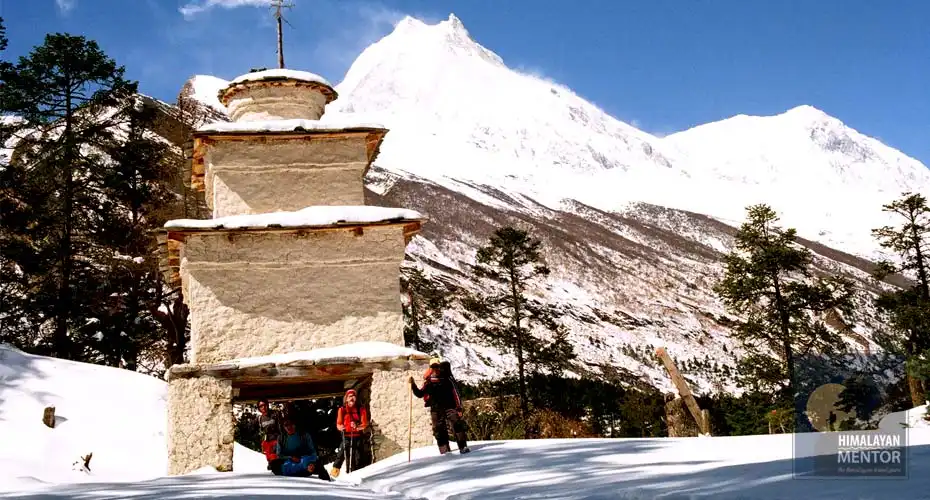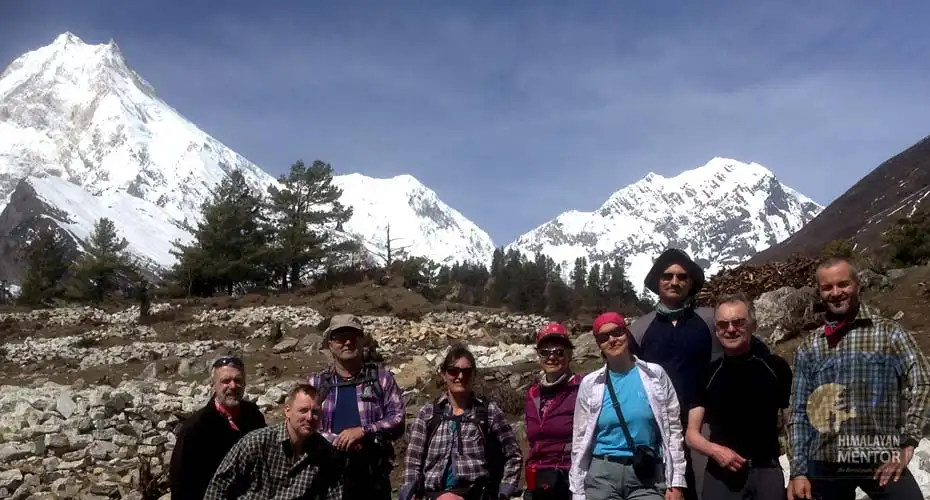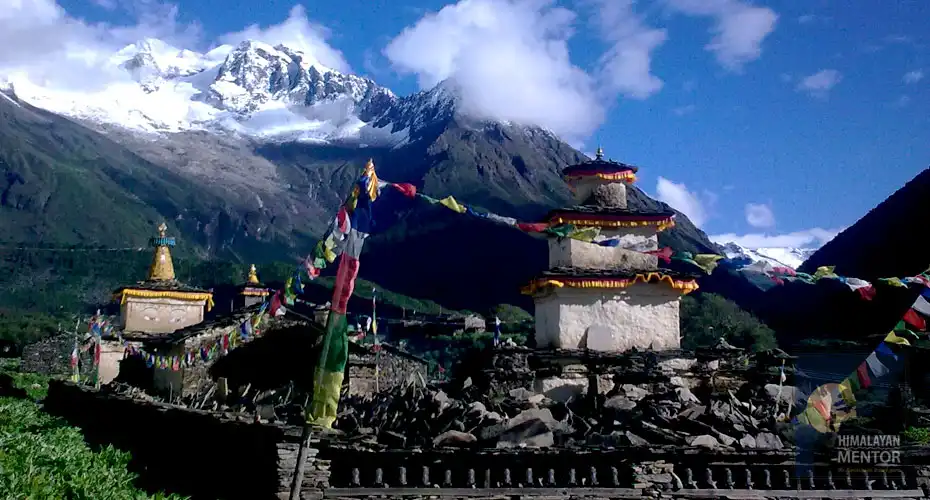Why Manaslu circuit trek considered as special trek?
The Manaslu Circuit Trek is renowned for its breathtaking scenery, rich cultural heritage, and sense of adventure.

Here are a few reasons why it's considered special:
Remote and Untouched Beauty: Unlike some of the more popular trekking routes in Nepal, such as the Everest Base Camp or Annapurna Circuit, the Manaslu Circuit remains relatively untouched by mass tourism. This means you get to experience pristine landscapes, remote villages, and unspoiled natural beauty.
Stunning Mountain Views: The trek offers spectacular views of the towering peaks of the Manaslu Range, including Manaslu itself, the eighth highest mountain in the world. You'll also encounter other majestic peaks like Himalchuli, Ganesh Himal, and Annapurna II, among others.
Cultural Diversity: Along the trail, you'll pass through a diverse range of landscapes and encounter various ethnic communities, including the Gurungs, Tamangs, and Tibetans. Each group has its own distinct culture, traditions, and architecture, adding depth and richness to the trekking experience.
Challenging Terrain: The Manaslu Circuit Trek is renowned for its challenging terrain, with steep ascents, descents, and narrow trails that traverse deep river valleys and high mountain passes. For adventure seekers, this adds an element of excitement and challenge to the journey.
Less Crowded: Compared to more popular trekking routes like Everest Base Camp or Annapurna Circuit, the Manaslu Circuit sees fewer trekkers. This means you'll often have the trails and teahouses to yourself, allowing for a more intimate and authentic experience amidst nature.
Conservation Area: The Manaslu region is designated as a conservation area, which means efforts are made to preserve its natural and cultural heritage. Trekking in this area supports local conservation initiatives and sustainable tourism practices.
Tsum Valley Extension: Many trekkers choose to combine the Manaslu Circuit Trek with an extension into the nearby Tsum Valley. This remote valley is known for its ancient Buddhist monasteries, traditional villages, and stunning mountain vistas, adding an extra layer of cultural and scenic richness to the trek.
Overall, the Manaslu Circuit Trek offers a unique and unforgettable adventure for trekkers seeking a combination of natural beauty, cultural immersion, and off-the-beaten-path exploration. To embark on your adventure trek to the Manaslu Circuit, Himalayan Mentor offers the following tips and guidelines:
Manaslu Circuit Trekking Tips and Guidlines
Know About the Best time for Manaslu Circuit trek
The optimal time for the Manaslu Circuit trek is during the spring (March to May) and autumn (September to November) seasons when the weather is typically stable, offering clear skies and comfortable temperatures for trekking.
Choose a Certified Trekking Agency
Nepal boasts numerous trekking agencies, each with its own unique offerings. However, it's imperative to select an authorized trekking agency. Not every enticing online travel deal is legitimate. Ensure the agency is registered with the Nepal Tourism Association and that their guides and porters possess proper licenses. A handy tip for the Manaslu Circuit trek: if you pack light, porters can manage two bags.
Compare Itineraries from Multiple Agencies
Numerous trekking agencies in Nepal provide similar Manaslu Circuit trek packages, but their itineraries and amenities can vary significantly. Additionally, the trekking routes may differ based on the agency. Instead of solely focusing on pricing, reach out to two or three agencies to request detailed itineraries before making a booking.
Evaluate Facilities Offered
While many trekking agencies claim to offer comprehensive packages, the quality and quantity of facilities can vary greatly. For instance, transportation methods may range from local buses to private vehicles. Ensure you inquire about:
- Inclusive meals, noting that some packages exclude meals in Kathmandu or limit your choices.
- Accommodation quality, especially in higher altitudes where options may be limited.
- Transportation mode during the trek.
- Ensure that you acquire essential information from the trekking agency and adequately prepare yourself for the journey.
Prepare Your Shopping List in Advance
Before embarking on your trek in the Himalayas of Nepal, ensure you have a comprehensive shopping list for the necessary gear and equipment. While these items are available in Nepal, the quality may not match that of products in your home country. It's particularly crucial for women to procure skincare products, sunglasses, and any other essentials before leaving home. Familiarize yourself with the items to purchase from your trekking agency to ensure you're fully equipped. Here's a detailed Manaslu Circuit Trek Packing list to guide you.

Physical Preparation for the Manaslu Circuit Trek
Contrary to what some bloggers may claim, tackling the Manaslu trek without adequate preparation is unwise. If you lack experience in high-altitude treks or haven't engaged in strength-building exercises, the journey can be arduous. While specialized mountain trekking training isn't necessary, improving your overall fitness through cardio workouts, gym sessions, cycling, and short hikes for at least two months beforehand can significantly enhance your trekking experience. Neglecting physical preparation may turn the journey into a painful ordeal.
Mental Preparedness
While the allure of the majestic mountains is often highlighted, it's essential to acknowledge the challenges that accompany the trek. From navigating through the pollution of Kathmandu to the inconveniences of restroom facilities and limited access to amenities, the journey may be daunting, especially for those accustomed to luxury. Additionally, disconnecting from social media and home comforts can pose mental challenges. Embrace the rejuvenating experience of the trek, but be mentally prepared to confront various obstacles along the way, even before finalizing your booking.
Obtain Travel Insurance
Merely booking your trip and flights isn't sufficient. Trekking packages in Nepal typically do not include insurance coverage, necessitating the acquisition of travel insurance. This is crucial for covering rescue operations in higher altitudes, including helicopter evacuations in Nepal. Travel insurance, costing around $200 or less depending on your location, is essential as altitude sickness or other illnesses may require emergency rescue. Without insurance, you won't have access to helicopter rescue services, underscoring the importance of securing comprehensive coverage before your journey.
Understanding Altitude and Its Symptoms
The pinnacle of the Manaslu Circuit Trek surpasses 5,000 meters, with other trekking regions ranging between 3,000 to 4,000 meters. This altitude presents a risk of Acute Mountain Sickness (AMS) if precautions aren't taken. Prior to embarking on the trek, it's essential to familiarize yourself with the symptoms and potential solutions. If possible, consult with your doctor to obtain medication to carry with you to Nepal.
Trekking at High Altitudes: Packing Essentials
One common mistake among trekkers is overpacking their bags. While you'll have a porter to assist, it's crucial to pack efficiently. Please consult with Himalayan Mentor for what you excatly need for this trek.
Opt for minimalism while ensuring you have everything to keep warm, aiming for a total weight of 15 to 20 kilograms. Porters can only manage a limited weight (10 kg from each trekker), and overpacking may result in inconvenience, forcing you to either carry the excess weight yourself or hire additional porters, which is less than ideal.
Ensure You Have Sufficient Cash on Hand
When booking your travel package, discuss payment options with the travel agency. Regardless of your choice, it's crucial to carry enough cash for personal expenses like meals in Kathmandu, beverages, and more. You can bring US dollars and exchange them at the airport or in areas like Thamel. Alternatively, ATMs in Kathmandu allow you to withdraw cash. However, once you leave Kathmandu, access to ATMs may be limited. It's advisable to carry around $170 (approximately NPR 20,000) in cash for your entire trekking journey.
Stay Hydrated
Staying hydrated is essential for combating altitude sickness. Aim to consume 3.5-4 liters of water daily, increasing to 5 liters if altitude sickness symptoms arise. Buying bottled water throughout the trek can be expensive, so carry a refillable bottle and purification tablets for the trip.
Opt for Vegetarian Meals and Soups
In high altitudes, opt for vegetarian meals rich in vitamins and fiber, which are easier to digest. Avoid meat, sodas, alcohol, and fried foods. Consider options like garlic soups and mushroom soups. For more dietary recommendations, refer to the full trek guide.
Respect Local Culture
The Himalayan region of Nepal boasts a unique culture and tradition. While locals welcome visitors warmly, it's important to show respect in return. Tea houses along the trek aren't commercial establishments but homes of the local people. Greet locals with a smile and "Namaste," wear appropriate clothing, refrain from public displays of affection, and show reverence at religious sites to honor local customs.

Ensure Sufficient Rest and Sleep
Quality sleep is crucial during the trek. Aim for 7 to 8 hours of sleep each night to allow your muscles to recover after hiking for 6-7 hours daily.
Carry Valuables and Snacks in Your Bag
Transport your valuables such as cash, gold, and cameras personally. Since porters may hike at their own pace, carry essentials like sunscreen, hand cream, and snacks in your personal bag to ensure easy access throughout the day.
